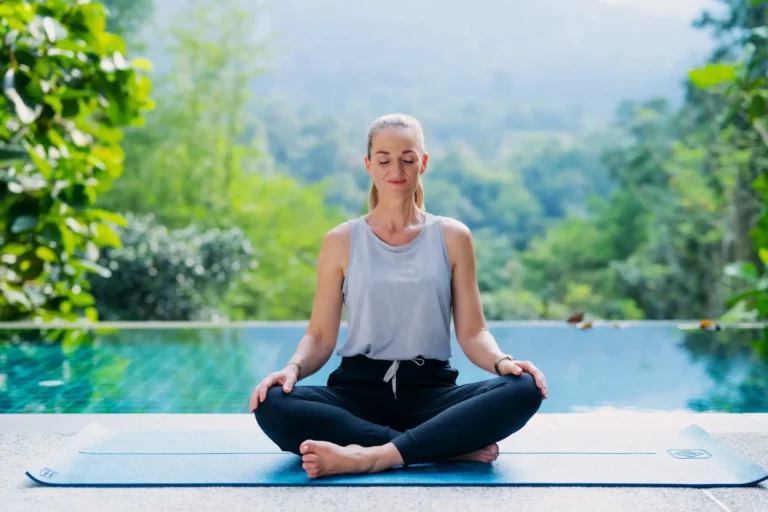Buddhist monks are known for their gentle calmness. Chaos? Drama? Hustle and bustle? No such thing is ever shown in the lives of these devotees.
This is not to say these things don’t exist in their world. But it seems there’s a secret to such stoicism.
Buddhist meditation—that’s the practice they use to counteract life’s stress, anxiety, and suffering. And if you’re feeling that, sometimes, the chaos is… well, too chaotic, then understanding and using this ancient philosophy could very well be the solution you’re looking for.
What is Buddhist meditation?
Originating from the teachings of the first Buddha, Siddhartha Gautama, Buddhist meditation is a way for you to train your mind. The practice, essentially, is to help you understand yourself better, tap into your awareness of the present, and develop qualities like peace, kindness, and wisdom.
This meditation practice in Buddhism comes in threes:
- Samatha, or mindfulness. You pay attention to what’s happening right now. Your breathing, sounds, or feelings, for example.
- Vipassana, or concentration. You focus on one thing, like a word or an image, and try not to get distracted.
- Metta, or loving-kindness. In this meditation, you send good wishes and love to yourself and to others.
The idea is that by practicing these Buddhist meditation techniques regularly, you’ll be able to become calmer, more understanding, and happier.
To start the meditation session, you sit on the floor or on a cushion, relax your shoulders, and keep your back straight. Direct your focus to a particular place, usually the breath.
As thoughts, sensations, and emotions arise, your mind will naturally drift toward them. But according to Gelong Thubten, a Buddhist monk and trainer of Mindvalley’s Becoming More Loving program, “meditation is not about clearing the mind; it’s about noticing you got lost, and then returning.”
So when you come to this realization, return to observing your breath.
What is the goal of meditation for Buddhists?
So why do Buddhists practice meditation? To begin with, Buddhist meditation aligns with the broader goals of Buddhism itself. Its ultimate goal is to achieve the ultimate state of enlightenment, also known as nirvana.
In Buddhism, there are eight right steps that will help lead you toward the path to enlightenment.
This series of principles is also known as the Eightfold Path to Enlightenment, and it includes the following:
- The right view or way of perceiving the world: See things without expectation, judgment, or preconceived notions. See things as they are.
- The right action: Work from a place of pure intentions (no harm to anyone or anything). No manipulating.
- The right speech: Say what you need to say, and say it from the heart.
- The right thought: Give up your tendency to complicate things by imposing your fantasy perceptions and expectations on how things should be. Take life as it is.
- The right livelihood: “Bloom where you’re planted” and do the best you can, with attention to detail and integrity, no matter your job. Even if you feel it’s totally wrong for you and your talents are better used elsewhere. Of course, you can change jobs, but don’t spend every 9 to 5 wishing you were somewhere else.
- The right effort: Practicing the Noble Eightfold Path consistently removes the need for struggle or the desire to overcome.
- The right mindfulness: You become mindful of the most minute, mundane, tiny details of your life experience. The way you talk, the way you stand, the way you walk, your thoughts, your emotions. And especially your actions, which have turned into habits.
- The right concentration: Most of the time, you run on autopilot, and your thoughts drift everywhere except the here and now. Meditation teaches you to discipline your mind so that it remains in the present.

Benefits of Buddhist meditation
It’s important to note that you don’t have to be a Buddhist to practice Buddhist meditation. What’s more, you don’t have to believe in anything spiritual or metaphysical, either.
All people from all walks of life can reap the benefits. And there’s science to back it up:
- It reduces stress and anxiety. According to a study from the General Hospital Psychiatry, people with anxiety who regularly practiced meditation over the course of three years experienced long-term improvements in their mental health. But not only that—meditation has been proven to also help reduce chronic stress and the body’s inflammation response to it.
- It helps fight addictions. Meditation’s ability to invoke a sense of calm and relaxation can help people with substance use problems control their impulses or even avoid relapse. One study of 60 people receiving treatment for alcohol use disorder found that practicing meditation led to lower levels of psychological distress, cravings, and alcohol use after 3 months. Another study found that mindfulness meditation also helps reduce emotional and binge eating.
- It improves sleep. The lights are off, and your phone’s in sleep mode. You’d love to be in sleep mode, too, but your brain decided to remind you of everything you have to do tomorrow. Meditation can help with that too. In fact, people who meditate stay asleep longer and experience fewer insomnia symptoms compared to those who don’t.
- It promotes emotional health. Not only can mindfulness meditation lead to improved self-image and well-being, but research suggests that it also helps reduce negative thoughts and symptoms of depression.
- It enhances focus and memory. Meditating can help increase the strength and endurance of your attention. So much so, that a simple 13-minute daily meditation can improve your focus and memory after just eight weeks.
These are only a handful of good things that come with practicing Buddhist meditation on the regular. And as it becomes part of your daily routine, you may just start to notice the monk-like calmness it brings to your life.
We meditate to get good at life, not to get good at meditation. — @ZivaMeditation Share on XHow to practice Buddhist meditation
Like most types of meditation, Buddhist meditation doesn’t necessarily require any equipment or accessories. It’s simply you and your wholeness.
Here’s a step-by-step of how to meditate in Buddhist meditation:
- Find a quiet place where you know that you won’t be disturbed. Make sure that your smartphone is silent and set a timer. If this is your first time, 5 to 10 minutes are enough. As time goes by, and you make Buddhist meditation a habit, try making 20 minutes your next goal.
- Sit in a comfortable place, like on the floor, in a chair, or on a cushion. Keep your back straight but relaxed, and close your eyes.
- Take a few deep breaths. Bring your attention to your breath: observe the flow of inhaling and exhaling. Notice any changes that happen in your abdomen, the tip of your nose, or your lungs.
- Be mindful of your thoughts. During your session, the mind will wander off many times, thinking, feeling, and doing what the mind always does. Every time this happens, your objective is to acknowledge it and guide your attention back to your breath.
The first few sessions can be discouraging, especially if you’re having trouble refocusing your mind on your breath. But don’t throw your hands up; keep going.
Thoughts are not bad for meditation. Thoughts are part of the mind, like waves in the ocean. Just let them be. The ocean is bigger than its waves. — @Gelong_Thubten Share on XThe Four Noble Truths (Buddhist tradition)
The Buddha’s first and most important teachings, also known as The Four Noble Truths, encapsulate the entire Buddhist path.
In his first sermon, he states that once he reached absolute knowledge of these four principles, he was able to achieve true enlightenment and lasting freedom from future rebirth.
In simple words, they express the inescapable truth that, yes, there is pain and suffering in life. But because this pain is caused, there is also a solution to overcome it.
Here are the Buddha’s Four Noble Truths in more detail:
- Life is painful and frustrating. Everything is constantly changing. Your new iPhone will someday be an old iPhone; you’ll get to the bottom of the ice cream; and you will eventually grow old. Even if things are okay right now, they won’t always be. Here, the Buddha is not denying the existence of happiness. Rather, he reminds us that the pleasure we so desperately chase can’t satisfy us.
- Suffering has a cause. Craving, or tanha, is the ultimate cause of this suffering. It represents the aimless pursuit of happiness in momentary pleasure, objects, and people. And it always ends with disappointment and dissatisfaction.
- The cause of suffering comes with an end to craving. The ignorance that keeps you trapped in this vicious cycle of craving is an indication of an untrained mind. But it’s not all bad news. If your mind is the cause of your suffering, it can also be the cure. Of course, freeing yourself from unhealthy attachments is not simply a matter of wishing them away.
- Meditation, or the practice of mindfulness and awareness, is the way to end suffering. The fourth noble truth uncovers the map that leads to the end of suffering, the Eightfold Path to Enlightenment. Its advice is to live ethically, practice mindfulness, and develop wisdom.
What happens then? Life becomes very simple. You begin to see things as they really are, NOT as you fantasize them to be. This brings about incredible inner peace and happiness.
5 tips for daily practice
Doing things on a daily basis makes them a habit. And incorporating meditation in this sense can absolutely enrich your life experience.
Here are five tips to help you along this journey, with insights from Mindvalley experts:
1. Practice non-attachment
Think about everything you hold dear in life. Non-attachment sounds almost impossible, right?
Many people, however, mistake it for being emotionally detached, cold-hearted, or insensitive.
In reality, it’s the exact opposite. It allows you to experience joy and freedom because you’re not attached to thoughts, material possessions, or people.
Life has its own way of unfolding. So focus on the inside. The more you search for happiness within you, the more you’ll realize that there’s no need to cling to anything.
Insight from Vishen: “Your soul isn’t here to achieve. Your soul is here to grow. Most people get this wrong. They become seduced by success and broken by failure.”
2. Improve your concentration
It’s essential to stay focused while meditating. If you’re jumping from one thought to another, you won’t be able to truly listen to your soul’s guidance.
But there’s no off switch for the mind. So how do you stop it from wandering?
It helps to make a conscious effort to tune all your worries out for a moment. Everyone deserves some peace and quiet. Stop worrying and overplanning, because guess what? All your problems will still be there when you open your eyes again.
Insight from Emily Fletcher: “Let it be still, and it will become gradually clear.”
3. Be mindful or present-aware
Present-moment awareness is simply a stillness in thought to fully observe the here and now.
As you can imagine, to-do lists, emotions, and worries are not invited to the party. Being present-aware is all about committing each moment to your senses, giving them your undivided attention.
And the best part is, you can practice it whenever and wherever you want.
So, next time you’re in the office, rather than rushing through lunch to get back to work, take the time to savor your food and the company instead. See how it feels.
Insight from Mahatria Ra: “A shift in attitude creates a shift in mindset, and a shift in mindset creates a shift in your life.”
4. Meditate
Around 95% of our behavior runs on autopilot. What are you doing with the other 5%?
Meditation is highly intentional, and the most important moment in your practice is the moment you sit down to do it. So find time to practice every day, even if it’s just for 10 minutes.
Because right at that moment, you’re telling yourself, “I believe I can change for the better; I care for myself, and I’m making it happen.”
Insight from Gelong Thubten: “You can take your meditation with you wherever you go. Practice micro-moments of mindful awareness many times per day.”
5. Be kind to yourself
“I will self-criticize my way to enlightenment,” said no one, ever.
When you think about it, meditation is like a rehearsal for the non-meditating parts of your life. Ultimately, it all comes down to the relationship you have with yourself.
Its whole purpose is to teach you acceptance, compassion, and unconditional love. So be gentle with your mind and all its craziness. Surrender to your true self and everything that’s happening—right here, right now.
Insight from Gelong Thubten: “Kindness begins with how we treat our own thoughts.”

Beyond bliss
There’s something beautiful when you reach the Zen-like state of a monk in meditation. It’s like an infinite light, weightless of burdens, and unjaded.
It does take practice to get there. With guidance from meditation experts like those at Mindvalley, you, too, can reach the awe state of calmness.
If you’re looking for a way to easily access these mindfulness practices, download the Mindvalley app and sign up for a free account. There are new guided meditations every day that you can use to bolster your journey.
What’s cool is that you can also change the background sounds to find what suits you best. Solfeggio frequencies? Brown noise? Ones that match your chakra healing? There are so many options to choose from.
And if you really want to know more about meditation, you can access the first few lessons of the Mindvalley program with your free account. Check out Vishen’s 6 Phase Meditation program, Gelong Thubten’s Becoming More Loving program, and Emily Fletcher’s The M Word program, just to name a few.
All it takes is one step (or, in this case, one meditation) at a time. Like Vishen, the founder of Mindvalley, has been known to say, “Baby steps are more powerful than you think.”
Welcome in.







